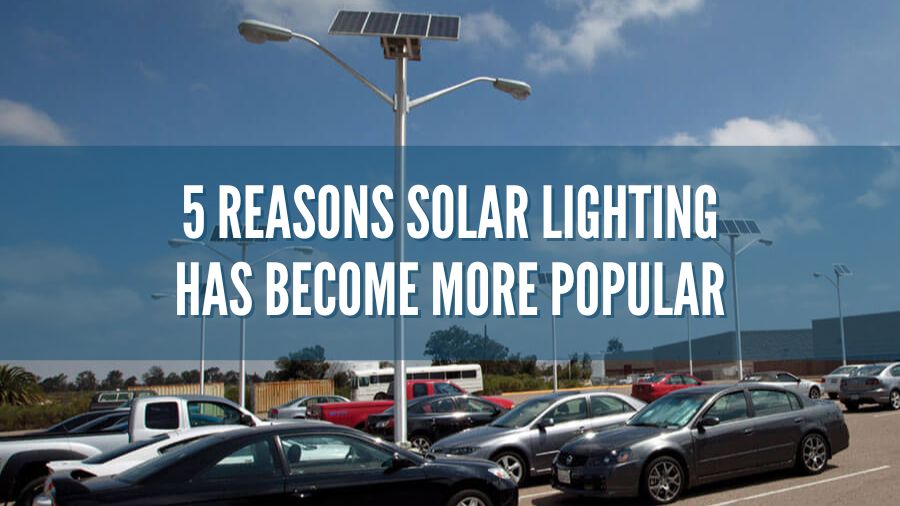5 Reasons Solar Lighting Has Become More Popular

Contents
Solar outdoor lighting systems have increased in popularity over the last decade for many reasons. Solar outdoor lighting solutions offer grid security, provide light in areas where grid power is still unavailable, and offer green alternatives to obtain power from the sun. Solar lights are becoming the new normal for new construction projects and provide cost savings when replacing old electrical underground infrastructure on failing systems. Here are the top five reasons solar lighting has become more popular in the last decade.
Grid Security
Failing grid power due to high demand, potential attacks, and the increasing frequency of natural disasters has raised concerns about the security of grid-powered lighting systems. In response to these concerns, many communities, like the City of Dania Beach, have opted to install off-grid solar lighting systems that do not rely on the grid power to keep the lights on.
In the aftermath of devastating hurricanes like Frances, Jeanne, and Wilma, the City of Dania Beach proactively decided to install off-grid solar lighting systems in a few neighborhoods. These solar lights were specifically designed to withstand hurricane-force winds, ensuring that the neighborhood still has reliable lighting even when the power is out after a storm.
This strategic move addressed the immediate need for lighting during power outages and provided a long-term solution to enhance grid security. By transitioning to off-grid solar lighting systems, communities can reduce their dependence on the vulnerable grid infrastructure, making them less susceptible to power disruptions caused by extreme weather events or deliberate attacks.
Federal, State, and Local Mandates
Many local cities now require the implementation of renewable energy in all new construction projects. This ensures compliance with green mandates and reduces the strain on existing grid systems. Off-grid solar lighting systems are a valuable solution for individuals and businesses looking to meet these requirements.
These mandates have been implemented to encourage adopting sustainable energy practices and reduce reliance on traditional power sources. By incorporating off-grid solar lighting systems into new construction projects, cities can demonstrate their commitment to environmental responsibility and contribute to reducing carbon emissions.
Furthermore, the Federal Energy Policy Act of 2005 outlines federal mandates requiring all federal facilities to use LEDs. This is part of an effort to decrease energy consumption and enhance energy security through the use of renewable power that operates independently of the electrical utility grid. Off-grid solar lighting systems align perfectly with these mandates, providing a reliable and sustainable lighting solution for federal facilities.
By implementing off-grid solar lighting systems, cities, and federal facilities can meet regulatory requirements and reap the benefits of reduced energy consumption and enhanced energy security. These systems offer a cost-effective and environmentally friendly alternative to traditional grid-powered lighting, making them an ideal choice for both new construction projects and retrofitting existing facilities.
No Available Power
There are several instances where the utility grid simply does not exist, making it impossible to rely on traditional lighting systems. These situations, often found in remote and rural areas, can pose a significant challenge regarding providing adequate lighting. However, solar outdoor lighting systems offer a practical and efficient solution in these cases.
Installing off-grid solar lighting systems in such areas can effectively extend power to otherwise difficult locations. Solar lights can provide a reliable and sustainable power source by harnessing the abundant sunlight available in these regions. With the correct sizing of battery backups, these systems can operate seamlessly under almost any condition for many years with minimal maintenance.
Green Alternative
More and more companies are looking for ways to use renewable energy to showcase their commitment to sustainability and the environment. For companies that are already comfortable with renewable energy, installing off-grid solar systems is a natural choice. These companies understand the value of solar energy and are eager to use the technology to reduce their carbon footprint. By installing solar outdoor lighting systems on their signs, parking lots, entrance roadways, and other areas, they can effectively demonstrate their support for green initiatives while reaping cost savings benefits.
On the other hand, companies that are just beginning to explore renewable energy options may find that starting with a small solar lighting system is a perfect jumping-off point. They see small systems, such as solar sign lighting systems, as a great way to dip their toes into the renewable energy pool and gain firsthand experience with the technology. Installing solar-powered lighting in specific areas allows them to test the technology and witness the benefits firsthand. This allows them to gradually integrate solar energy into their operations and evaluate its effectiveness before making larger investments.
Regardless of the size of the solar lighting system, every little bit helps the environment. By using renewable energy sources like solar power, companies can reduce their reliance on traditional energy sources and contribute to a cleaner, more sustainable future. Not only does this demonstrate their commitment to environmental responsibility, but it also allows them to showcase their green initiatives to customers, employees, and stakeholders.
Save Money
The costs associated with off-grid solar lighting systems may initially seem daunting, but these systems have the potential to save a significant amount of money in both the short and long term. Unlike traditional lighting systems that require costly trenching for grid power, solar lighting systems can be installed simply by setting up a pole and wiring up the lighting system, greatly reducing installation costs.
Another advantage of solar lighting systems is their ability to replace failing grid-tied lighting without disrupting the surrounding areas. This means that replacements can be installed without the need to redo other sections of the construction, saving both time and money.
In addition to these cost-saving benefits, numerous incentives are available at the federal, state, and local levels that can further reduce the overall costs of solar outdoor lighting systems. These incentives are specifically designed to support the adoption of solar technology and ensure that projects remain within budget. Regularly updated information about these incentives can be found at www.dsireusa.org. By staying informed about your area's latest updates and incentives, you can significantly lower the costs of implementing solar lighting systems. It's worth noting that some incentives can even be applied to the installation costs, providing additional savings.
Considering the continuous reduction in the cost of solar technology, it's becoming an increasingly viable alternative to grid power lights. Solar energy is now more widely trusted and used, making it a mainstream option for a variety of projects. If you have a project where cost considerations are important, it's worth exploring the benefits of solar outdoor lighting systems. Discuss your specific requirements with a lighting professional to determine if solar is a feasible and cost-effective alternative for your next project.

